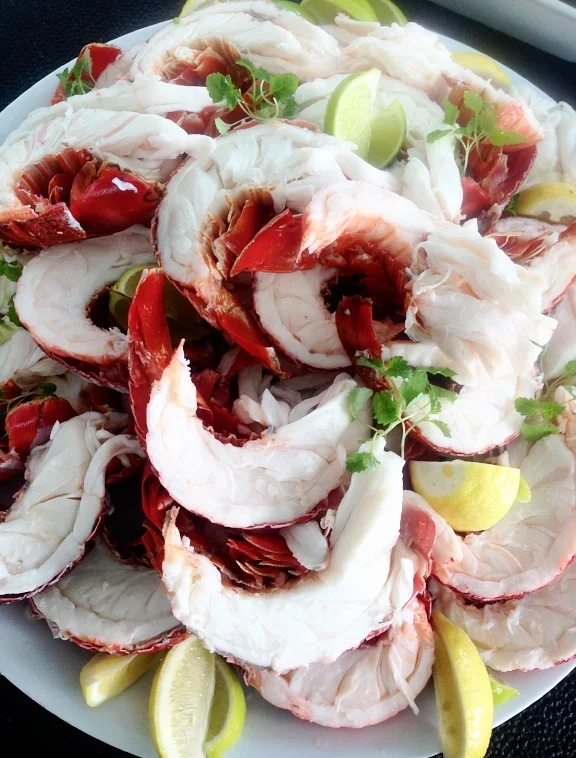You can find Hokkien Popiah in pretty much every hawker’s market throughout Singapore. Slow cooked vegetables, Yam bean sauce and garlic complimented by slices of meat and garlicky prawns are enveloped in a very thin almost crepe-like wrap called Popiah skin. It is then sliced and devoured!
This delicious and unique street food favourite would be perfect with some Australian twists. So after some careful research here in Singapore, we have tweaked a few traditional elements used in Popiah to include WA prawns, kangaroo sausage, native basil and bush tomato relish.
Popiah skins can be bought fresh or frozen at various Chinese food stores and Asian supermarkets. If you have trouble finding them, a recipe for the ambitious cook has been included, so you can make them from scratch!
AUSTRALIAN - STYLE POPIAH
Makes 10
Ingredients:
Base Filling
2 tbsp peanut oil
4 tsp minced garlic
1 tsp minced ginger
1 tsp chopped native lemongrass
50g carrots, shredded
80g green beans, thinly sliced
50 grams cooked Japanese yam - or even better, cooked native Youlk
60g shredded white cabbage
150g fresh WA endeavour prawns
200g chopped kangaroo sausage (or kangaroo mince)
300ml chicken stock
1 tsp soy sauce
salt and pepper
Additions:
10 pieces Popiah skin (fresh or frozen) or alternatively spring roll wrappers
1/2 cucumber, peeled, seeded and julienned
2 eggs, boiled and chopped
50g, roasted and chopped macadamia nuts
100g beansprouts
2 large native basil leaves, blanched, chilled and chopped
4 iceberg lettuce leaves, chopped
10 Tbsp bush tomato relish
Directions
1. In a wok or frying pan, gently sauté 2 tsp garlic, ginger and lemongrass in oil. Add kangaroo sausage or mince and sauce until cooked though. Set aside on plate. Add stock to pan and bring to boil.
2. Add prawns to stock until just cooked through, remove with slotted spoon, allow to cool, then peel and chop. Strain and reserve stock. Clean pan.
3. Saute 2 tsp garlic in oil until softened, gradually add the shredded vegetables, native lemongrass and soy sauce. Once slightly soften, pour in reserved stock until vegetables are just covered. Let simmer for 20-30 mins until much of the liquid has disappear and vegetables are soft, but not mushy. Strain vegetables and squeeze slightly to remove excess liquid. Set aside.
4. Now it is time to make some native Australian flavoured Popiah! Separate a sheet of popiah skin and lay on a clean flat surface.
5. At one end, lay some lettuce leaves and top with a Tbsp each of the additional ingredients. Only add 1 tsp of the native basil as it is quite strong. Top with 1 tbsp bush tomato relish, kangaroo sausage, macadamias, cucumber strips, bean sprouts and finally chopped prawns.
6. Roll into a compact spring roll shape (though it will be larger than your usual spring roll), tuck both ends in midway through.
7. Eat as a whole roll or slice into pieces!! Yum!
*** Homemade Popiah skins*** Makes 10-20
WARNING: Getting the skins perfectly even and thin takes practice, so keep trying!
Ingredients:
500g plain high protein flour
1 tbsp tapioca or corn flour
salt and peper
2 c water
Directions
Combine ingredients and mix into a lumpy batter. Lift the batter up out of the bowl and let it drop down. You are essentially working the batter, or kneading it, until it starts to pull together into a dough.
Once you reach a soft dough-like consistency, lay out in clean pan, cover and put in fridge overnight to ‘set’
Take dough out - you will notice it has become more doughy and less like a batter.
Heat a cast iron griddle, and quickly take a handful of the dough. Smear it around the base of the pan in a big circle so that some of the dough sticks to the pan, lifting up quickly to remove excess dough. Any thick bits on the crepe=like circle can be picked off with a ball of dough to unstick them.
When the edges start to curl and all the moisture has evaporated from the skin, remove from the pan. Repeat with another lump of dough until all are made.


